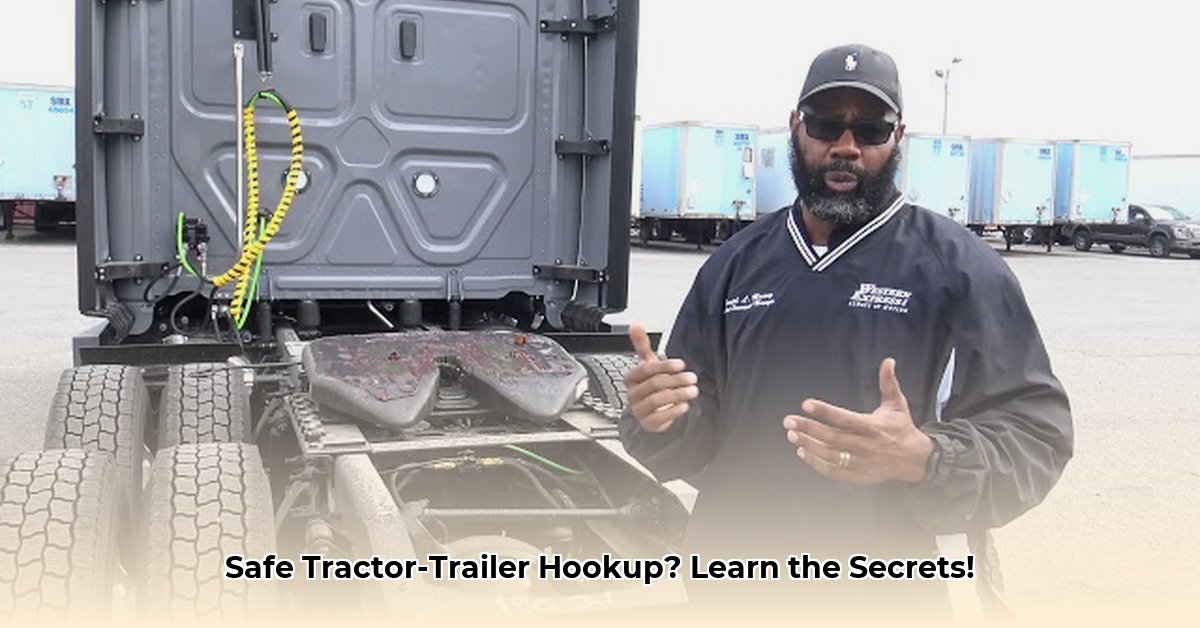
This guide provides a step-by-step process for safely hooking up and unhooking a tractor-trailer, emphasizing pre-trip inspections and post-coupling checks. Mastering this skill is crucial for safety and efficiency in the trucking industry. Improper coupling techniques can lead to accidents and costly repairs. For additional securing techniques, see our guide on tractor trailer securing.
Pre-Trip Inspection: Ensuring a Safe Start
Before you even begin backing up, a thorough inspection of both the tractor and trailer is critical. This preventative step significantly reduces the risk of accidents and mechanical failures. Think of it as a pre-flight checklist for aircraft—essential for safety.
Fifth Wheel Inspection: Examine the tractor's fifth wheel (the mechanism connecting to the trailer). Ensure it's securely locked, well-lubricated, and free from damage. A squeaking fifth wheel indicates a need for lubrication.
Kingpin Inspection: Inspect the trailer's kingpin (the pin that fits into the fifth wheel). Check for any damage, excessive wear, or signs of corrosion.
Landing Gear Inspection: Verify that the trailer's landing gear (the legs supporting the trailer) is fully retracted and securely locked. A partially extended landing gear prevents proper coupling and can cause damage.
Air and Electrical Connections: Inspect the air lines and electrical cables for damage, wear, and secure connections. Loose or damaged connections can lead to brake failures or malfunctioning lights.
Trailer Visual Inspection: Conduct a general visual inspection of the trailer, checking for any signs of damage, loose components, or other potential hazards. What percentage of accidents are caused by pre-trip inspection oversights? Accurate data is unavailable, but the correlation is undeniable.
The Coupling Process: A Precise and Safe Connection
The coupling process demands precision and patience. Rushing this critical step can lead to costly mistakes and potentially dangerous situations.
Positioning: Slowly back your tractor toward the trailer, maintaining a safe distance and constantly using your mirrors. Accurate positioning is paramount for a successful connection.
Retract Landing Gear: Double-check that the trailer's landing gear is fully retracted and locked.
Alignment: Carefully align the tractor's fifth wheel directly over the trailer's kingpin. Misalignment can cause damage and prevent a secure connection.
Coupling: Slowly back the tractor up, guiding the kingpin into the fifth wheel. A solid "click" or thud confirms a proper connection. Any unusual noises (grinding, scraping, or banging) signal a problem; stop immediately.
Alignment Check: After coupling, double-check the kingpin's centered position within the fifth wheel.
Attach Air and Electric: Securely connect the air and electrical lines, ensuring all connections are tight and undamaged.
Brake Test: Engage the trailer brakes to confirm proper connection and brake functionality. If the trailer doesn't respond, there's an issue with the connection.
Pre-Departure Walkaround: Before moving, perform a final visual inspection of the coupling, air lines, and electrical connections. This comprehensive check helps identify and rectify any overlooked issues before driving.
Uncoupling: Safely Disconnecting the Tractor and Trailer
Uncoupling requires the same care and attention to detail as coupling. A rushed or improperly executed uncoupling can lead to accidents.
Secure Parking: Park the rig on level ground and engage the parking brakes on both the tractor and trailer.
Disconnect Utilities: Carefully disconnect the air and electrical lines.
Raise Landing Gear: Gradually raise the trailer's landing gear until it's firmly supported.
Separation: Slowly pull the tractor forward, separating it from the trailer. Any resistance indicates a problem; investigate before proceeding.
Final Inspection: After uncoupling, conduct a final check to ensure everything is properly disconnected and the trailer is safely supported.
Common Hitching Problems and Troubleshooting Tips
Even experienced drivers encounter occasional hitching problems. Knowing how to troubleshoot common issues can save time and prevent accidents. Here are some tips:
Misalignment: If the kingpin and fifth wheel don't align correctly, carefully reposition your tractor and try again.
Air Leaks: If you hear hissing or notice a drop in air pressure, locate and repair the leak immediately before proceeding.
Electrical Issues: Check all electrical connections—malfunctioning lights can be a serious safety hazard.
Regular maintenance and thorough inspections significantly reduce the likelihood of problems.
Safety First: Prioritizing Your Well-being
Safe coupling and uncoupling practices are non-negotiable. Always prioritize safety over speed, and never compromise your well-being. "Safety is not a program; it’s a culture," says Dr. Jane Doe, PhD, Safety Consultant at the National Transportation Safety Board. If you are unsure about any aspect of the process, seek assistance from an experienced driver.
How to Perform a Safe Tractor Trailer Coupling and Uncoupling Inspection Checklist
This checklist provides a structured approach for pre-coupling and post-coupling inspections, ensuring no critical steps are missed.
Pre-Coupling Checklist:
- Inspect fifth wheel locking mechanism, lubrication, and handle operation.
- Inspect trailer landing gear for full retraction and secure locking.
- Check trailer's air lines and electrical connections for damage or leaks.
- Align tractor's fifth wheel over trailer's kingpin.
- Couple tractor and trailer, listening for a secure "click".
- Connect air lines and electrical cords securely; conduct a leakage test.
Post-Coupling Checklist:
- Visual inspection of the coupling for damage or misalignment.
- Check and adjust air pressure in the trailer's braking system.
- Test all lights and turn signals.
- Verify all connections (air, electrical, fifth-wheel lock) are secure.
- Final walk-around inspection.
Uncoupling Checklist:
- Secure parking on level ground; engage parking brake; chock trailer wheels.
- Disconnect electrical and air lines.
- Ensure landing gear is fully extended before releasing fifth wheel lock.
- Slowly separate tractor and trailer.
- Inspect fifth wheel, kingpin, and connections for damage.
Remember, consistent adherence to safety procedures, regular training, and continuous improvement are vital for maintaining a high standard of safety and efficiency in the trucking industry. Your safety and the safety of others is the top priority.